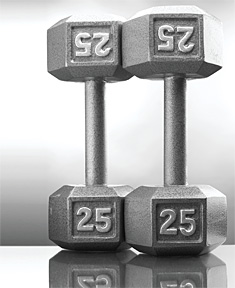Don't Fear the Weights
By Dr. Perry Nickelston
With the popularity of stability balls, bands and resistance tubing, many people tend to forget that lifting free weights is a fundamental tool for increasing lean muscle and burning body fat. And no, you won't end up looking like a hulking, muscle-bound body-builder - unless that's your goal, of course - if you do it right. Here's a simple program for using weights to your advantage.
In this day and age of fancy gym equipment, group exercise classes, and late night infomercial, in-home workout gadgets, it's easy to lose sight of one of the most effective forms of exercise available: free weights. There are misconceptions about weight training that prevent people from truly understanding the value it provides in shaping your body, developing lean muscle, and improving athletic and day-to-day performance. Women are especially prone to neglecting this form of effective training for fear of getting "too muscular" or looking "too bulky." This is unfortunate, because when done correctly, weight training is a great way to make a noticeable difference in how your body feels, looks and performs.
It all comes down to developing lean muscle and burning unwanted body fat. Hands down, the quickest way to accomplish this is with weight training. Why? Because muscle is anabolic, meaning your body needs calories to sustain it. The more muscle you have, the faster your metabolism work and the more body fat you burn. You look and feel better. Now that sounds like a win-win to me.
Designing a Program That's Right for You
 The key to effective weight-lifting is learning how to design an effective program based on your fitness level and goals. Once you have an end target in mind, you can formulate a road map for getting there safely while enjoying the process. Some fundamental questions to ask yourself prior to beginning a weight training program include the following:
The key to effective weight-lifting is learning how to design an effective program based on your fitness level and goals. Once you have an end target in mind, you can formulate a road map for getting there safely while enjoying the process. Some fundamental questions to ask yourself prior to beginning a weight training program include the following:
- How many days per week can I realistically exercise? Three days minimum is suggested, preferably with a day of rest in between each exercise day.
- How much time can I allocate to work out per exercise session? Twenty minutes is ideal for most people, up to a maximum of 45 minutes.
- Am I trying to build size or simply tone muscle? A quicker, lighter pace is more for toning, while a heavier, slower pace generally builds muscle size and strength.
- Do I have more than 10 pounds of body fat to lose? Do higher reps at a quicker pace to maximize fat loss.
- How much experience do I have with weight training? Be careful not to over-exercise. Progress slowly; remember, if you get hurt, you won't be able to exercise at all!
The answers to these questions will determine the amount, tempo and frequency of your training program. Here's a sample free-weight program to get you started. Make sure you talk to your doctor before beginning the program, particularly if you have a health condition that could limit the types and/or duration of exercises you perform, or if you need assistance figuring out how to perform any exercises. Remember, think safety first.
It's also important to know the "lingo" in the world of free-weight training so when you're told to do three sets of 10 reps of an exercise, emphasizing the concentric phase," you know what the heck that means. Review the list of terms on the facing page before starting your program, and always make sure you can lift the weight safely and without excessive effort/straining for the desired number of repetitions. (You may need to experiment with different weights in the beginning until you find the weight you can handle.)
A Sample Full-Body Routine
The following routine should be performed on Monday - Wednesday - Friday, with a complete day of rest in between. As you advance, you can add some cardio on your "off" days to keep your metabolism up and fat burning at a premium. These exercises should be "giant-setted" (see glossary), meaning that you should do one set of each exercise one after the other, with only minimal rest to set up the next exercise, change weights, etc. Only after you've completed the entire "giant set" of all exercises for all body parts should you rest for a minute or two. Then repeat the giant set a second time. This workout consists of two sets of 12-15 reps of each of the following exercises:

